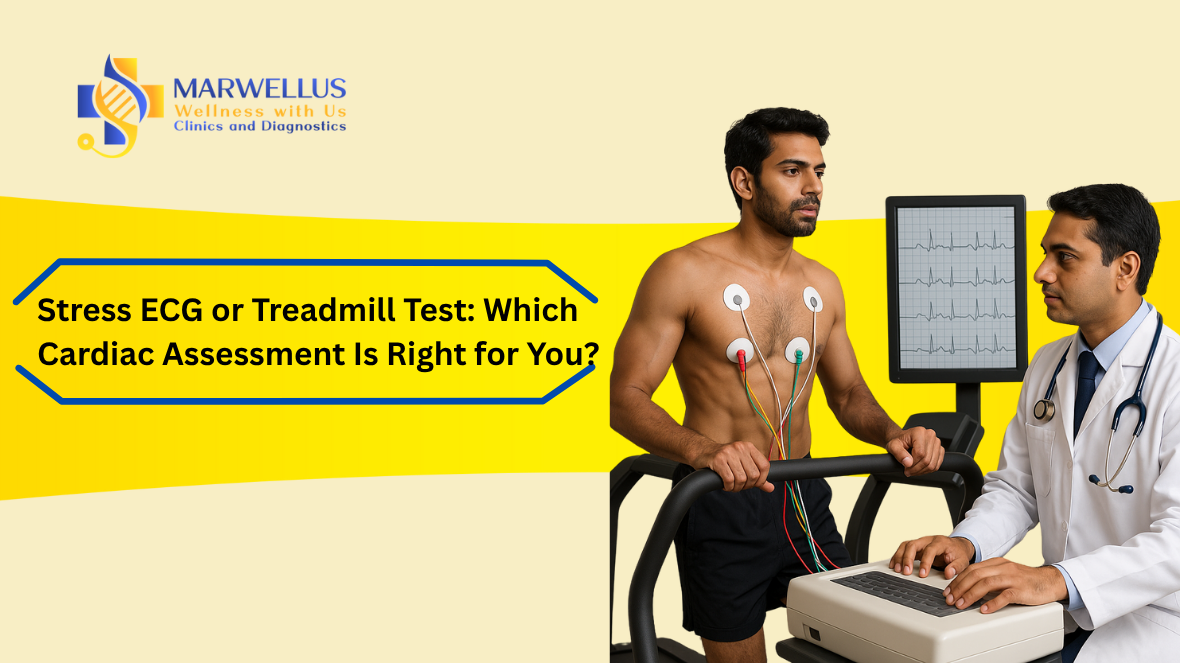



If you experience chest discomfort, you may find yourself confused about which cardiac test to undergo. Stress ECG and treadmill tests are common assessments, but understanding their differences can help you choose the right test. This blog will clarify what each test involves and guide you on selecting the right cardiac assessment for your heart health.
A stress ECG, also known as an exercise electrocardiogram, measures your heart’s electrical activity at rest and during physical exertion. Electrodes are placed on your chest to record your heart’s rhythms while you exercise, typically on a stationary bike or treadmill. The test monitors how your heart responds to stress and detects abnormalities that may indicate blocked arteries or other cardiac issues. Stress ECG is a reliable, non-invasive, and cost-effective way to assess heart health.
The treadmill exercise test involves walking on a treadmill with gradually increasing speed and incline, following a standard protocol such as the Bruce protocol. During the test, your heart rate, blood pressure, and ECG are continuously monitored. The exercise continues until you reach a target heart rate, experience symptoms, or meet other medical endpoints. This test evaluates how well your heart performs under physical stress and can help diagnose coronary artery disease.
While stress ECG and treadmill tests are closely related, there are differences in their indications and accuracy. The treadmill test specifically refers to exercising on a treadmill, whereas stress ECG can involve different forms of exercise. Both tests measure electrical activity but differ in exercise modality.
Treadmill tests often provide more controlled and graded exercise levels, increasing accuracy in detecting cardiac issues. However, for patients unable to perform physical exercise, pharmacological stress tests might be recommended. Imaging stress tests, such as stress echocardiograms, may follow if further evaluation is needed. Cost and availability can vary, but both tests are widely accessible and useful in routine cardiac assessment.
Choosing between a stress ECG and a treadmill test depends on your health status and risk factors. Often, these tests are performed together, as the treadmill test involves walking on a treadmill while your heart’s electrical activity is monitored through an ECG. This combined approach provides a comprehensive assessment of your heart’s response to exercise.
This test is particularly useful for patients with symptoms like chest pain or shortness of breath during physical activity, or those with intermediate risk factors for heart disease. For a deeper look into how the treadmill test with ECG works and what it reveals about your heart, check out our detailed blog Treadmill Test with ECG: How It Works and What It Reveals About Your Heart.
Before your cardiac test, avoid heavy meals and caffeine, and follow your doctor’s advice on medications, which may include pausing certain drugs. Wear comfortable shoes and clothing suited for exercise. After the test, you might feel tired or sweaty, but you can usually resume normal activities soon. Always inform your healthcare provider of any symptoms experienced during or after the test.
Selecting the right cardiac test is essential for accurate diagnosis and effective treatment. Tailored advice from a cardiologist ensures you undergo the most suitable assessment for your heart health. Understanding the differences between stress ECG and treadmill tests can help you make informed choices about your cardiac care.
Unsure about which cardiac test is best for you? Book a consultation at Marwellus Clinic & Diagnostic Centre with our experienced cardiac team, and they will evaluate your symptoms and risk factors. You will be guided throughout the process, ensuring the most accurate and suitable assessment for your heart health. Take control of your well-being today with professional support.